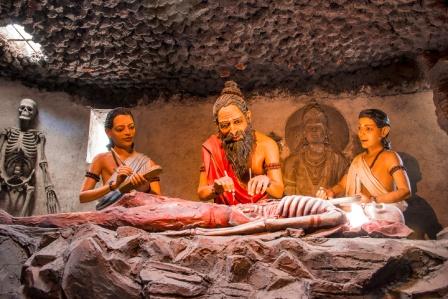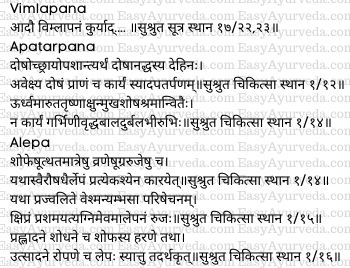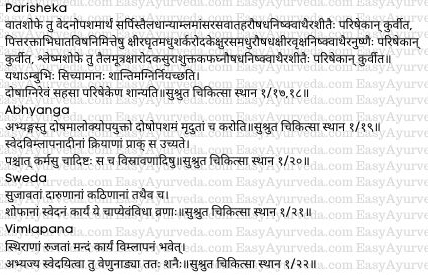Avasechana Method of Wound Care: Meaning, Types, Clinical Significance
By Dr Raghuram Y.S. MD (Ay) & Dr Manasa, B.A.M.S
Avasechana is the second type of treatment mentioned amongst ‘Sapta Upakrama’ i.e. the 7 types of treatments mentioned by Master Sushruta which are meant to treat and heal the wounds, ulcers and related swelling.
Read – Sushruta’s 7 Types of Treatments Sapta Upakrama

Table of Contents
Avasechana
Avasechan means to expel the doshas. It is comprised of 4 treatments and done after Vimlapana (first treatment amongst 7 treatment procedures). Vimlapana means softening the wound / swelling associated with ulcers. ‘Secondly avsechan should be done…!’
Avasechana means ‘to remove / expel the doshas’. It comprises of 4 measures which need to be skillfully administered as and when needed, depending on the condition of the disease and the diseased. They include bloodletting or drainage of ulcers / swelling (containing contaminated fluids), oleation, therapeutic emesis and purgation. These measures are 4 among the 60 kinds of treatments explained by Master Sushruta (Shashti Upakrama) in the first chapter of Chikitsa Sthana. The set of these 4 treatments together comprise avasechana.
Read – Shashti Upakrama Meaning, Classification, Clinical Significance
Types
Below mentioned are the 4 treatments which help in cleansing the swelling, ulcers and wounds by enabling the expulsion of doshas either triggering or worsening them so as to enable comprehensive healing. These measures should be undertaken only after having administered the treatments included under vimlapana.
1. Visravana – drainage / bloodletting
Master Sushruta has given importance to the blood tissue and has considered it as the 4th dosha. Vitiated blood is invariably involved in either causing the wounds, ulcers or swelling (inflammation) or complicating the mentioned conditions. Contaminated blood may also be accumulated in these wounds and swellings. Therefore bloodletting will be one of the main treatment strategies in these conditions.
Conditions for doing bloodletting
If the swelling around the wound is suppurating the patient should be given with food in a quantity of one’s comfort. In swelling that has freshly manifest bloodletting should be done to provide relief from pain and to prevent suppuration. Bloodletting is beneficial in elevated or depressed wounds associated with swelling / inflammation, hardness, dark brown (dark color) or golden yellow / red / reddish brown color, congested, broad or deep rooted. In swellings consisting of poisons bloodletting should be done by means of leech application and scraping / scarifying procedures.
Read – Raktamokshana Benefits, Types, Procedure, Indications
2. Snehapana – oleation therapy
Oleation should be administered –
- for providing relief from pain
- to prevent suppuration of wound / swelling (to prevent formation of pus)
- when the wound / ulcer / swelling is associated with complications
- when the patient is dry (devoid or has less of fat in the body)
- when the patient is thin / emaciated
- when the patient has been debilitated by ulcers / wounds
Medicated oil or ghee prepared with herbs specific for mitigating involved dosha, have cleansing property, can produce unctuousness, relieve pain, prevent suppuration and complications shall be used skillfully.
Read – Oleation – Snehakarma Dose, Benefits, Side Effects, Management
3. Vamana – therapeutic emesis
Therapeutic emesis shall be administered when –
the wound / ulcer is surrounded by elevated muscles (muscles raised above the surface of the wound)
the wound caused by vitiated kapha
there is accumulation of blackish colored blood in the wound / ulcer or swelling
Read – Vamana Therapy – Right Method, Side Effects, Management
4. Virechana – therapeutic purgation
Therapeutic purgation shall be administered in wounds and ulcers / swelling –
- caused by vitiated vata
- having predominant vitiation of pitta
- which have become chronic
Read – Virechana Therapy – Right Method, Side Effects, Management
Sanskrit Verses


Summary
The above said measures help in purification of the wounds, swelling and ulcers of their contaminants and doshas. Pathological increase of doshas or blood in the body may also influence on the wounds / ulcers / swelling and may either aggravate or complicate the picture of the disease.
Therefore timely cleansing therapies shall be administered taking into consideration the dosha or blood which has been vitiated and causing the disease. These procedures will not only expel the morbid doshas but also help in proper and comprehensive healing of ulcers / wounds / swelling. Removal or expulsion of doshas / contaminants (i.e. visravana) shall be done after the first treatment (set of treatments which include) vimlapana. Following visravana the third treatment procedure mentioned amongst 7 treatments i.e. upanaha – applying poultice / unguent shall be administered if need be.
Click to Consult Dr Raghuram Y.S. MD (Ayu)








